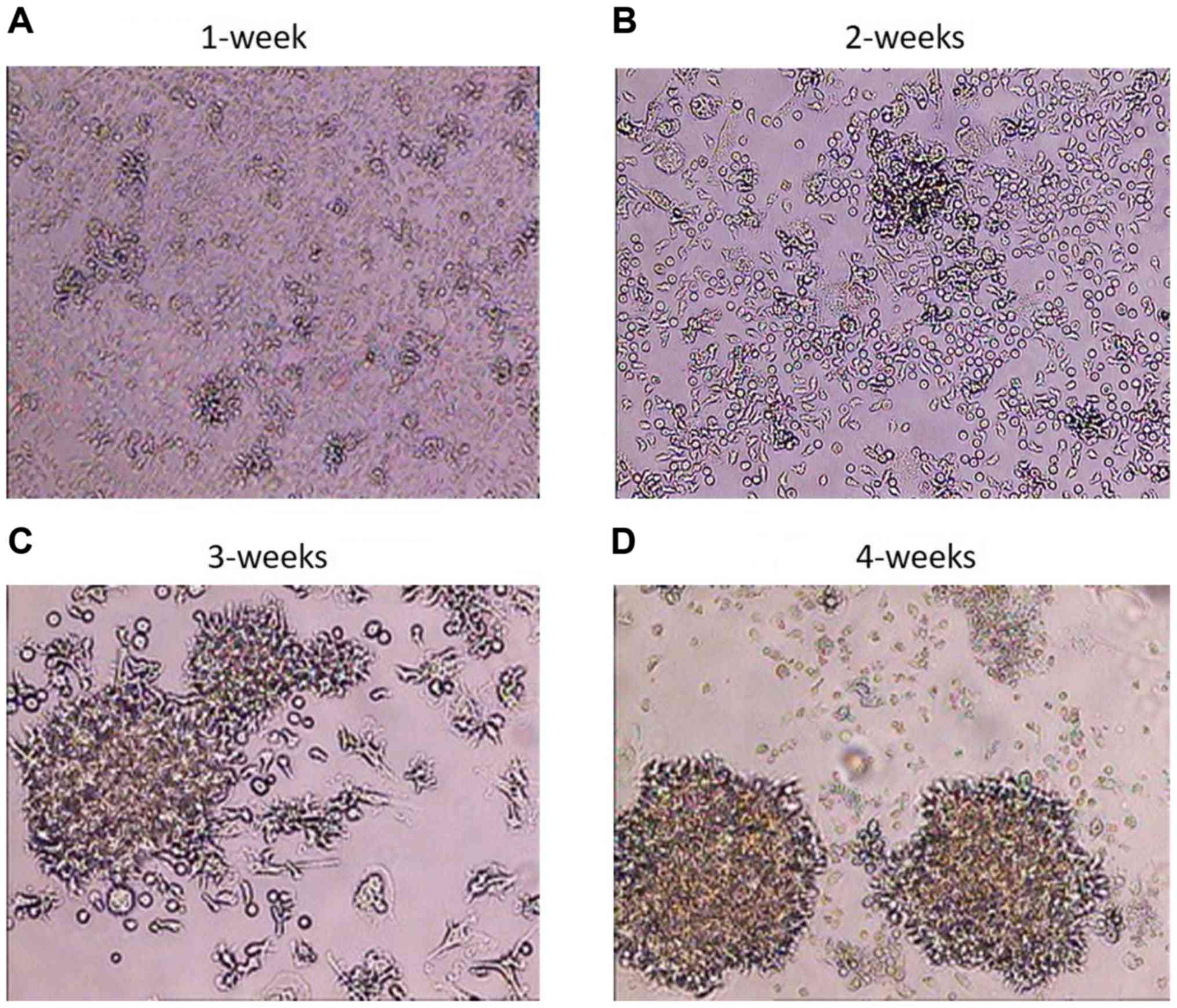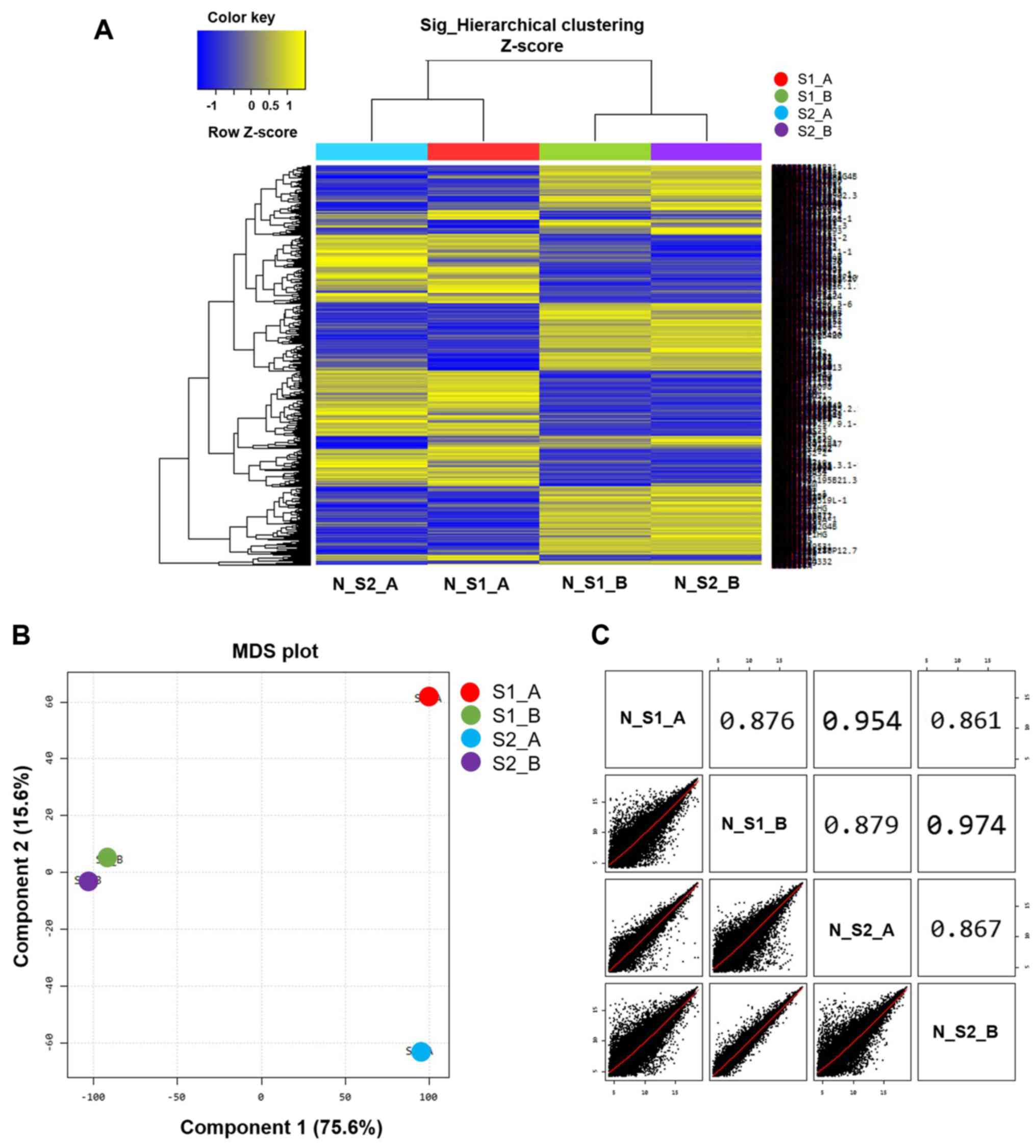|
1
|
Balfour HH Jr, Sifakis F, Sliman JA,
Knight JA, Schmeling DO and Thomas W: Age-specific prevalence of
Epstein-Barr virus infection among individuals aged 6-19 years in
the United States and factors affecting its acquisition. J Infect
Dis. 208:1286–1293. 2013.PubMed/NCBI View Article : Google Scholar
|
|
2
|
Condon LM, Cederberg LE, Rabinovitch MD,
Liebo RV, Go JC, Delaney AS, Schmeling DO, Thomas W and Balfour HH
Jr: Age-specific prevalence of Epstein-Barr virus infection among
Minnesota children: Effects of race/ethnicity and family
environment. Clin Infect Dis. 59:501–508. 2014.PubMed/NCBI View Article : Google Scholar
|
|
3
|
Hjalgrim H, Friborg J and Melbye M: The
epidemiology of EBV and its association with malignant disease. In:
Human Herpesviruses: Biology, Therapy, and Immunoprophylaxis. Arvin
A, Campadelli-Fiume G, Mocarski E, Moore PS, Roizman B, Whitley R
and Yamanishi K (eds). Cambridge, 2007. https://doi.org/10.1017/CBO9780511545313.054.
|
|
4
|
El-Sharkawy A, Al Zaidan L and Malki A:
Epstein-Barr virus-associated malignancies: Roles of viral
oncoproteins in carcinogenesis. Front Oncol. 8(265)2018.PubMed/NCBI View Article : Google Scholar
|
|
5
|
Esmeray E and Küçük C: Genetic alterations
in B cell lymphoma subtypes as potential biomarkers for noninvasive
diagnosis, prognosis, therapy, and disease monitoring. Turk J Biol.
44:1–14. 2020.PubMed/NCBI View Article : Google Scholar
|
|
6
|
Li CW, Jheng BR and Chen BS: Investigating
genetic-and-epigenetic networks, and the cellular mechanisms
occurring in Epstein-Barr virus-infected human B lymphocytes via
big data mining and genome-wide two-sided NGS data identification.
PLoS One. 13(e0202537)2018.PubMed/NCBI View Article : Google Scholar
|
|
7
|
Saha A and Robertson ES: Mechanisms of
B-cell oncogenesis induced by Epstein-Barr Virus. J Virol.
93(93)2019.PubMed/NCBI View Article : Google Scholar
|
|
8
|
Hutt-Fletcher LM: Epstein-Barr virus
replicating in epithelial cells. Proc Natl Acad Sci USA.
111:16242–16243. 2014.PubMed/NCBI View Article : Google Scholar
|
|
9
|
Rowe M and Zuo J: Immune responses to
Epstein-Barr virus: Molecular interactions in the virus evasion of
CD8+ T cell immunity. Microbes Infect. 12:173–181. 2010.PubMed/NCBI View Article : Google Scholar
|
|
10
|
Wanvimonsuk S, Thitiwanichpiwong P,
Keelawat S, Mutirangura A and Kitkumthorn N: Distribution of the
Epstein-Barr virus in the normal stomach and gastric lesions in
Thai population. J Med Virol. 91:444–449. 2019.PubMed/NCBI View Article : Google Scholar
|
|
11
|
Jha HC, Pei Y and Robertson ES:
Epstein-Barr virus: Diseases linked to infection and
transformation. Front Microbiol. 7(1,602)2016.PubMed/NCBI View Article : Google Scholar
|
|
12
|
Tulalamba W and Janvilisri T:
Nasopharyngeal carcinoma signaling pathway: An update on molecular
biomarkers. Int J Cell Biol. 2012(594681)2012.PubMed/NCBI View Article : Google Scholar
|
|
13
|
Atsaves V, Leventaki V, Rassidakis GZ and
Claret FX: AP-1 transcription factors as regulators of immune
responses in cancer. Cancers (Basel). 11(11)2019.PubMed/NCBI View Article : Google Scholar
|
|
14
|
Hanahan D and Weinberg RA: Hallmarks of
cancer: The next generation. Cell. 144:646–674. 2011.PubMed/NCBI View Article : Google Scholar
|
|
15
|
Park HW, Dahlin A, Qiu W and Tantisira KG:
Gene expression changes in lymphoblastoid cell lines and primary B
cells by dexamethasone. Pharmacogenet Genomics. 29:58–64.
2019.PubMed/NCBI View Article : Google Scholar
|
|
16
|
Wang C, Li D, Zhang L, Jiang S, Liang J,
Narita Y, Hou I, Zhong Q, Zheng Z, Xiao H, et al: RNA sequencing
analyses of gene expression during Epstein-Barr virus infection of
primary B lymphocytes. J Virol. 93(93)2019.PubMed/NCBI View Article : Google Scholar
|
|
17
|
Hui-Yuen J, McAllister S, Koganti S, Hill
E and Bhaduri-McIntosh S: Establishment of Epstein-Barr virus
growth-transformed lymphoblastoid cell lines. J Vis Exp.
(57)(3,321)2011.PubMed/NCBI View
Article : Google Scholar
|
|
18
|
Bolstad BM, Irizarry RA, Astrand M and
Speed TP: A comparison of normalization methods for high density
oligonucleotide array data based on variance and bias.
Bioinformatics. 19:185–193. 2003.PubMed/NCBI View Article : Google Scholar
|
|
19
|
Raudvere U, Kolberg L, Kuzmin I, Arak T,
Adler P, Peterson H and Vilo J: g:Profiler: A web server for
functional enrichment analysis and conversions of gene lists (2019
update). Nucleic Acids Res. 47 (W1):W191–W198. 2019.PubMed/NCBI View Article : Google Scholar
|
|
20
|
Kanehisa M: Post-genome informatics.
Oxford University Press, Oxford, UK, 2000.
|
|
21
|
R Core Team: (2012). R: A language and
environment for statistical computing. R Foundation for Statistical
Computing, Vienna, Austria. ISBN 3-900051-07-0. http://www.R-project.org/.
|
|
22
|
The Gene Ontology Consortium. The Gene
Ontology Resource: 20 years and still GOing strong. Nucleic Acids
Res. 47 (D1):330–338. 2019.PubMed/NCBI View Article : Google Scholar
|
|
23
|
Ashburner M, Ball CA, Blake JA, Botstein
D, Butler H, Cherry JM, Davis AP, Dolinski K, Dwight SS, Eppig JT,
et al: The Gene Ontology Consortium: Gene ontology: Tool for the
unification of biology. Nat Genet. 25:25–29. 2000.PubMed/NCBI View
Article : Google Scholar
|
|
24
|
Baik SY, Yun HS, Lee HJ, Lee MH, Jung SE,
Kim JW, Jeon JP, Shin YK, Rhee HS, Kimm KC, et al: Identification
of stathmin 1 expression induced by Epstein-Barr virus in human B
lymphocytes. Cell Prolif. 40:268–281. 2007.PubMed/NCBI View Article : Google Scholar
|
|
25
|
Hussain T and Mulherkar R: Lymphoblastoid
cell lines: A continuous in vitro source of cells to study
carcinogen sensitivity and DNA repair. Int J Mol Cell Med. 1:75–87.
2012.PubMed/NCBI
|
|
26
|
Jeon JP: Human lymphoblastoid cell lines
in pharmacogenomics. In: Handbook of pharmacogenomics and
stratified medicine. Padmanabhan S (ed). Academic Press, San Diego,
pp89-110, 2014.
|
|
27
|
Kato H, Karube K, Yamamoto K, Takizawa J,
Tsuzuki S, Yatabe Y, Kanda T, Katayama M, Ozawa Y, Ishitsuka K, et
al: Gene expression profiling of Epstein-Barr virus-positive
diffuse large B-cell lymphoma of the elderly reveals alterations of
characteristic oncogenetic pathways. Cancer Sci. 105:537–544.
2014.PubMed/NCBI View Article : Google Scholar
|
|
28
|
Carter KL, Cahir-McFarland E and Kieff E:
Epstein-barr virus-induced changes in B-lymphocyte gene expression.
J Virol. 76:10427–10436. 2002.PubMed/NCBI View Article : Google Scholar
|
|
29
|
Mrozek-Gorska P, Buschle A, Pich D,
Schwarzmayr T, Fechtner R, Scialdone A and Hammerschmidt W:
Epstein-Barr virus reprograms human B lymphocytes immediately in
the prelatent phase of infection. Proc Natl Acad Sci USA.
116:16046–16055. 2019.PubMed/NCBI View Article : Google Scholar
|
|
30
|
Wasil LR and Shair KHY: Epstein-Barr virus
LMP1 induces focal adhesions and epithelial cell migration through
effects on integrin-α5 and N-cadherin. Oncogenesis. 4:e171.
2015.PubMed/NCBI View Article : Google Scholar
|
|
31
|
Chesnokova LS, Nishimura SL and
Hutt-Fletcher LM: Fusion of epithelial cells by Epstein-Barr virus
proteins is triggered by binding of viral glycoproteins gHgL to
integrins αvβ6 or αvβ8. Proc Natl Acad Sci USA. 106:20464–20469.
2009.PubMed/NCBI View Article : Google Scholar
|
|
32
|
Weber GF, Bjerke MA and DeSimone DW:
Integrins and cadherins join forces to form adhesive networks. J
Cell Sci. 124:1183–1193. 2011.PubMed/NCBI View Article : Google Scholar
|
|
33
|
Birdwell CE, Prasai K, Dykes S, Jia Y,
Munroe TGC, Bienkowska-Haba M and Scott RS: Epstein-Barr virus
stably confers an invasive phenotype to epithelial cells through
reprogramming of the WNT pathway. Oncotarget. 9:10417–10435.
2018.PubMed/NCBI View Article : Google Scholar
|
|
34
|
Shackelford J, Maier C and Pagano JS:
Epstein-Barr virus activates beta-catenin in type III latently
infected B lymphocyte lines: Association with deubiquitinating
enzymes. Proc Natl Acad Sci USA. 100:15572–15576. 2003.PubMed/NCBI View Article : Google Scholar
|
|
35
|
Yang CF, Yang GD, Huang TJ, Li R, Chu QQ,
Xu L, Wang MS, Cai MD, Zhong L, Wei HJ, et al: EB-virus latent
membrane protein 1 potentiates the stemness of nasopharyngeal
carcinoma via preferential activation of PI3K/AKT pathway by a
positive feedback loop. Oncogene. 35:3419–3431. 2016.PubMed/NCBI View Article : Google Scholar
|
|
36
|
Sun L, Zhao Y, Shi H, Ma C and Wei L:
LMP-1 induces survivin expression to inhibit cell apoptosis through
the NF-κB and PI3K/Akt signaling pathways in nasal NK/T-cell
lymphoma. Oncol Rep. 33:2253–2260. 2015.PubMed/NCBI View Article : Google Scholar
|
|
37
|
Pei Y, Lewis AE and Robertson ES: Current
progress in EBV-associated B-cell lymphomas. Adv Exp Med Biol.
1018:57–74. 2017.PubMed/NCBI View Article : Google Scholar
|
|
38
|
Sobhani N, D'Angelo A, Pittacolo M,
Roviello G, Miccoli A, Corona SP, Bernocchi O, Generali D and Otto
T: Updates on the CDK4/6 inhibitory strategy and combinations in
breast cancer. Cells. 8(8)2019.PubMed/NCBI View Article : Google Scholar
|
|
39
|
Wong CH, Ma BBY, Hui CWC, Lo KW, Hui EP
and Chan ATC: Preclinical evaluation of ribociclib and its
synergistic effect in combination with alpelisib in
non-keratinizing nasopharyngeal carcinoma. Sci Rep.
8(8010)2018.PubMed/NCBI View Article : Google Scholar
|
|
40
|
Chen F, Shen C, Wang X, Wang H, Liu Y, Yu
C, Lv J, He J and Wen Z: Identification of genes and pathways in
nasopharyngeal carcinoma by bioinformatics analysis. Oncotarget.
8:63738–63749. 2017.PubMed/NCBI View Article : Google Scholar
|
|
41
|
Yang H, Zhang X, Cai XY, Wen DY, Ye ZH,
Liang L, Zhang L, Wang HL, Chen G and Feng ZB: From big data to
diagnosis and prognosis: Gene expression signatures in liver
hepatocellular carcinoma. PeerJ. 5(e3089)2017.PubMed/NCBI View Article : Google Scholar
|
|
42
|
Chujan S, Suriyo T, Ungtrakul T, Pomyen Y
and Satayavivad J: Potential candidate treatment agents for
targeting of cholangiocarcinoma identified by gene expression
profile analysis. Biomed Rep. 9:42–52. 2018.PubMed/NCBI View Article : Google Scholar
|


















